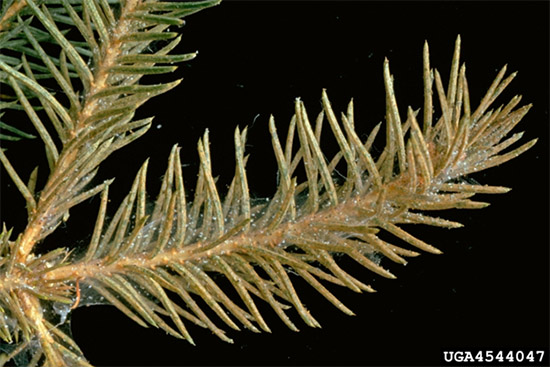Issue 16, September 26, 2018
Spruce Spider Mite
Now that temperatures are beginning to fall in Illinois, conditions are becoming favorable for spruce spider mite (Oligonychus ununguis). Spruce spider mites are typically active in spring and fall when temperatures are cool and become inactive during the hot summer months. Active mites will feed on various needled evergreens including spruces, pines and junipers. In the fall, mites will feed on first-year needles and needles from previous years.
Spruce spider mites are too small to be seen clearly without a hand magnifying lens but their feeding damage can be more easily identified. Mites suck fluids from small clusters of plant cells causing discoloration that will eventually give needles a brown speckled appearance called stippling. From a distance, this discoloration can make the needles appear bronze. Spruce spider mites can also be identified by the presence of fine silk among the needles.

Petr Kapitola, Central Institute for Supervising and Testing in Agriculture, Bugwood.org
When scouting for spruce spider mites, it is important to confirm that mites are present in injured areas and determine what type of mites are present. One way to do this is the paper test. For this test, hold a sheet of blank paper below an affected branch and firmly strike the branch. The impact should cause the mites to fall onto the paper where they can be more easily inspected. Using a hand lens, identify whether the mites on the paper are green or red. If a hand lens is not available, it may be necessary to smash the mites to discern the color. Green coloration indicates that the mites are herbivores while red indicates that the mites are predatory, feeding on other mites. If the population is composed of herbivorous mites and you are experiencing aesthetic damage, you can treat for the mites. If red mites are present, they may be feeding on the spruce spider mites. Consider the relative abundance of red and green mites. Over time, the predatory mites may control the spruce spider mites well enough that no chemical treatments are needed.
When controlling for spruce spider mite, it is best to choose a miticide. Some chemical miticides include acequinocyl (Shuttle), bifenthrin (Onyx, Talstar), fenazaquin (Magus) or spiromesifen (Forbid). Mites can also be controlled with insecticidal soap or summer oil. It is important to remember that miticides will be effective in killing both herbivorous and predatory mites so they should not be used if you would prefer to encourage an existing population of predatory mites. (Sarah Hughson)
Author:
Sarah Hughson